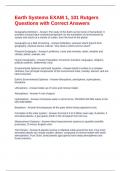Earth Systems EXAM 1, 101 Rutgers
Questions with Correct Answers
Geography Definition - Answer-The study of the Earth as the home of humankind. It
provides a broad place-centered perspective on the translation of environments by
society and nature at a variety of scales, from the local to the global.
Geography as a field of learning - Answer-Definition, sciences which branch from
geography, physical versus cultural, "why what is where and so what?"
Physical Geography - Answer-Landforms, rocks and minerals, water, weather and
climate, plants, animals, soil.
Human Geography - Answer-Population, Economic Activities, languages, religions,
political systems, settlements, food.
Environmental Spheres and Earth Systems - Answer-Earth's surface is a complex
interface, four principal components of the environment meet, overlap, interact, and are
interconnected.
Earth's Environmental Spheres - Answer-lithosphere, atmosphere, hydrosphere,
biosphere
Lithosphere - Answer-Made up of rocks and mineral matter.
Atmosphere - Answer-A mix of gases
Hydrosphere - Answer-Comprises water in all its forms, FROZEN WATER exists in the
CRYOSPHERE.
Biosphere - Answer-Encompasses all the parts where living organisms exist.
Formation of the solar system - Answer-Formed 4.5 to 5 billion years ago, 8 planets, 4
terrestrial planets, 4 gas giants, Earth is the 3rd planet from the sun.
Measurement Systems - Answer-Need measurement systems to quantify scientific
processes, SI versus English units.
The Planets - Answer-8 planets revolve in elliptical orbits around the Sun, Four inner
terrestrial planets are mostly smaller, denser, composed of mineral matter with small
atmospheres, Four Outer Jovial planets (gas giants) have deep atmospheres and
frozen interiors.
, The size and shape of the Earth - Answer-Physical characteristics - Equatorial diameter
- 12,756km, Polar diameter - 12,714km, Circumference of 40,000km
Earths Shape - Answer-Oblate Spheroid, bulges at the equator, flattens at the poles, not
quite spherical. Rotating body with pliable rocks.
Latitudes - Answer-Parallels, 7 important Latitudes: Tropic of Cancer and Capricorn,
Poles, Equator, The Arctic and Antarctic Circle, Latitude zones
Tropic of Cancer - Answer-24.5 degrees North
Tropic of Capricorn - Answer-24.5 degrees South
Poles - Answer-90 degrees latitude North and South
The Arctic and Antarctic Circle - Answer-66.5 degrees N and S
Equator - Answer-0 degrees latitude
Arctic Circle - Answer-Rovanimemi, Finland
Longitudes - Answer-Meridians, Prime meridian ( 0 degrees longitude ) located at
Greenwich, England, Converge at the poles
Earth-Sun Relations and Seasons - Answer-Earth rotates on its Axis every 24 hours
from WEST TO EAST
Rotation speed - Answer-Slowest at poles, fastest at Equator. Rotation of counter
clockwise.
One revolution takes - Answer-365 1/4 days
Elliptical orbit - Answer-Aphelion, FARTHEST AWAY FROM SUN IN JULY, Perihelion,
CLOSER TO SUN IN JANUARY
When are we closer to the sun? (Northern Hemisphere) - Answer-During Winter
Earth perihelion - Answer-Closer to Northern Hemisphere during winter
Earth Aphelion - Answer-Away from Northern Hemisphere during summer
Orbital Properties - Answer-Plane of the Earth's orbit is the plane of the ecliptic
Earth's axis tilt - Answer-23.5 degrees
Plane of the ecliptic is not parallel where? - Answer-Not parallel to the equatorial plane.




